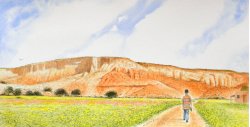
From Southwest Sunrise by Nikki Grimes & Wendell Minor © 2020 by Bloomsbury

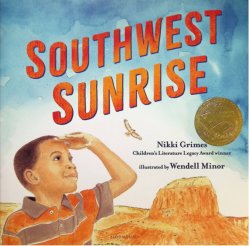
Reviewed By Maughn Rollins Gregory
A genuine philosophical inquiry into the natural world has to begin with a genuine encounter with that world. In this arresting picture book, written by Nikki Grimes, recipient of the American Library Associations’ Children’s Literature Legacy Award, with stunning art by Wendell Minor, a young Black boy named Jayden from New York City is forced into such an encounter when his parents relocate to the desert of New Mexico. That he is Black is significant, because, as Grimes explains elsewhere, there is a “rarity of children’s books that feature African American characters engaging with nature” (2023). In this review I will draw out the suggestions this book offers for experiencing a natural landscape deeply, as a necessary condition for thinking well about it.
Though the book’s front endpapers show a colorful, sunny panorama of the New York skyline, we learn later that Jayden’s bedroom window there had bars, and that the city’s soundscape was typified by “the familiar sound of sirens.” Page one shows Jayden on an airplane seat, thinking:
The next morning those shadows are parted by “a knife of sunlight / slicing through the room / Dad says is mine,” and though Jayden is sure that “Everybody knows / browns and tans / are the only colors / deserts are good for,” the first thing he sees out his new bedroom window is “a mountain / striped in rainbow.”
But Jayden’s real encounter with his new environment begins when he steps outside “to take a look around, / gripping the field guide / Mom gave me at breakfast.” One of the ways this book works is as a guidebook with tips for young and old to encounter the natural world around us. The first tip is to use field guides that identify the geographical formations, plants, and animals in our location. In addition to helping us learn about what we see around us, field guides prompt us to notice things we may otherwise overlook. This is what happens to Jayden, who finds the wildflower “called wine-cup / spilling its burgundy beauty / for me to drink up. / And aren’t those yellow bells? / They wake up the desert with their silent ring. / […] There’s a patch of calypso orchids! […] / dancing purple in the wind.”
Wouldn’t it be fun to get some local field guides and find formations and species you don’t recognize and go looking for them in your neighborhood?

From Southwest Sunrise by Nikki Grimes & Wendell Minor © 2020 by Bloomsbury
The more important tip Jayden shows us is how to pay attention to nature with all our senses. He spends long moments looking up trying “to understand / the deep waves of turquoise / overhead.” (“Where was all this sky / in New York City?” he wonders. “Was it hiding?”) But he also remembers to “lower my eyes / to watch where I’m going.” On the ground he meets a “kingly” raven “parading by,” and then a striped lizard, “one stunned cousin / of the alligator,” whose “curved digits skitter / across my palm.” Jayden remarks on colors, textures, and sounds, including “the mad chatter” of magpies, “winged gossips / passing secrets / from one unfamiliar tree to another,” and periods of unbroken silence that make him shiver.
Try this: pick a spot outside where you can sit for five or ten minutes and make notes of what you can see, hear, touch, smell, and taste. Are there any sensations you can’t identify? How do you think other living things around you might see, hear, touch, smell, or even taste you?
Another tip we learn from Jayden is to be curious about what we encounter in the natural world and find ways to learn more. Coming on a “river of sand” that “washes up bleached bones / like seashells / at Jones Beach: / rib, bird’s skull, turtle shell,” he wonders, “What stories / do they have to tell?”
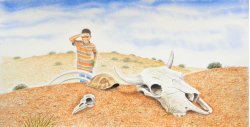
From Southwest Sunrise by Nikki Grimes & Wendell Minor © 2020 by Bloomsbury
As the expressions on his face make clear, Jayden is continually surprised and increasingly delighted by what he discovers in his new desert home. The strangeness of the landscape makes him encounter it with what is known in Zen Buddhism as shoshin or “beginner’s mind,” without preconceptions. He is able to be surprised and curious. But beginner’s mind is something we can cultivate in familiar circumstances—in our work, our relationships, and our physical surroundings—by trying not to know what to expect.
Try this:
We learn another tip for encountering nature from the Grimes’ metaphor-drenched narrative. In addition to “a knife of sunlight,” and a “wine-cup” wildflower “spilling its burgundy beauty,” the kingly raven has “feathers slick as wet hair,” the magpies “write across the sky / with the long black tips / of their tails,” and there are “red rock pillars / holding up the sky.”
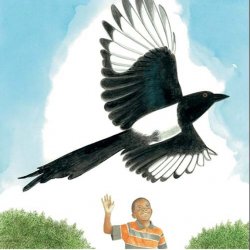
From Southwest Sunrise by Nikki Grimes & Wendell Minor © 2020 by Bloomsbury
The artistic impulse has always drawn children to nature. Grimes depicts this in another outstanding picture book, A Walk in the Woods (2023), in which another Black boy walks in nature. Following a map left to him by his recently-deceased father, this boy discovers a cache of “Drawings! Portraits of / wildlife in the woods” with an “unfinished story / scrawled beneath each sketch,” made by his father when he was a boy. The stories read like poems:
Garter Snake
Quick!
Someone’s coming to gather
the sun-beaten diamonds
along your coiled,
cold-blooded body.
I wonder how much
Those diamonds are worth?
Hurry!
Slither behind those rocks
leading into the woods.
I’ll see you again, tomorrow.
Try this: After spending some time in a natural setting, make a drawing, painting, sculpture, poem, or song about something you find there.
Because he knows to remind himself to slow down, to breathe, to pay close attention, and to respect and admire the beings he encounters in the woods, this boy’s walk assuages his grief and sustains his relationship to his late father. These contemplative practices are among the most important tips to having a meaningful experience in the natural world (also, as this boy does, to bring a handful of nuts!).
Try this: Find a place to sit or walk in a natural setting and try to stop thinking and only pay attention to the sights, sounds, smells, and textures you experience. Each time you find your mind wandering away in thought, gently bring it back to the sensations you experience in the present moment.
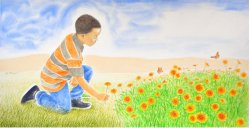
From Southwest Sunrise by Nikki Grimes & Wendell Minor © 2020 by Bloomsbury